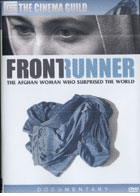
Frontrunner: The Afghan Woman Who Surprised The World 2007
Distributed by Cinema Guild, 115 West 30th Street, Suite 800, New York, NY 10001; 212-685-6242
Produced by Rory O’Connor and Halima Kazem
Directed by Virginia Williams
DVD, color, 90 min.
Jr. High - Adult
Gender Studies, History, Human Rights, Middle Eastern Studies, Political Science, Women's Studies
Date Entered: 08/14/2008
Reviewed by Linda Alkana, Department of History, California State University Long BeachIn 2004 Massouda Jalal, a medical doctor and mother of three, was the first woman to run for President of Afghanistan. Two years earlier, following the defeat of the Taliban, she emerged from the forced seclusion of women imposed by that regime, and was encouraged to run for office after giving a well-received speech on the rights of women and a peaceful future for Afghanistan. Frontrunner: The Afghan Woman who Surprised the World documents Dr. Jalal’s campaign for the Presidency of Afghanistan—the only woman in a field of 17 candidates.
This well-made film opens with a view of the Afghan countryside—a highway through a valley, camels, children, veiled women, a truck and some balloons. A transistor radio transmits the voice of a woman who says she wants “to see once again the Afghanistan of our youth, peaceful and free.” The appeal of this message is made more poignant when contrasted with a quick, but powerful, scene of a woman being executed during the Taliban period. Although there are other references to that time—primarily through interviews—the focus of the film is on the nitty-gritty’s of conducting a presidential campaign with much of the world watching. Dr. Jalal’s supporters (United Nations and human rights representatives, women, men, young people and religious figures) are as varied as are her opponents, comprised of a mix of regional warlords, religious figures and the American- supported Hamid Karzai, who eventually wins the election. Despite the financial and military might of her opponents, Dr. Jalal takes to the streets and to the airwaves (where she is given limited access) with her message of unity for a more peaceful Afghanistan. The film follows her into photo sessions, mosques, street markets, and a radio station, where she replies to a skeptical call-in listener’s concern about Muslim women rulers, by pointing out that Bangladesh, Pakistan and Indonesia are all Muslim countries that have already had women leaders.
The coverage of Election Day is particularly interesting, involving election irregularities and candidates dropping out in opposition to them. Dr. Jalal is eventually defeated, but over 500 women ran for parliament within the next 5 months—a testament to Dr. Jalal’s belief that she was running to “wake up the mentality of leadership for the women of Afghanistan.” The film closes with Dr. Jalal in New York City, where she represented her country in the United Nations as Afghanistan’s Minister of Women’s Affairs.
This is a timely documentary, but it should be viewed with an understanding of the increasing turmoil in Afghanistan, including the apparent resurgence of the Taliban. It would be a mistake to view Frontrunner only as an account of one woman’s triumphant quest for a more “peaceful and free Afghanistan,” since such a vision of Afghanistan is increasingly challenged by internal and geopolitical forces. Nonetheless, Frontrunner stands on its own, documenting, as it does, a moment of hope for women, peace and democracy in a troubled part of the world.